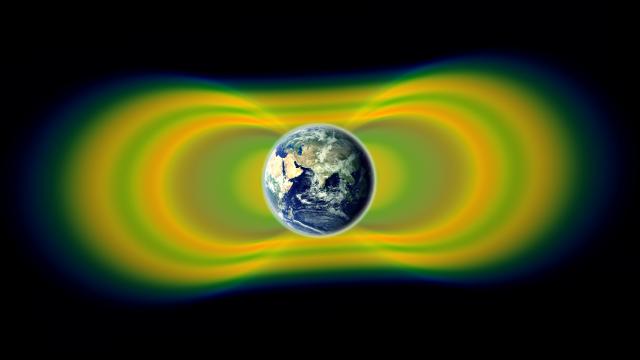Oh, that Van Allen Belt – online crackpots love to use Earth’s belt of radiation to bolster their Moon landing conspiracies, suggesting it could be too strong for an astronaut to travel through (not true). But the truth is, scientists do think about the Van Allen Belt and its mysteries. They have launched probes to study the region since they weren’t sure where some of that radiation came from.
Image: NASA/Van Allen Probes/Goddard Space Flight Center
The belt consists of charged particles such as protons and electrons trapped by Earth’s magnetic field between 483km and 40,234km above the Earth’s surface. It helps protect the planet from dangerous space weather. Scientists have long known the source of the positively-charged protons – they’re the product of cosmic rays colliding with particles in Earth’s atmosphere – but they were unsure if the same source supplied the negatively-charged electrons. A student-built satellite may have answered that question.
The satellite, called the Colorado Student Space Weather Experiment, was built by a team of graduates and undergraduates at the University of Colorado, Boulder. The 4.5kg, burrito-sized satellite has a proton- and electron-detecting device on board that can measure the directions and density of the particles travelling through it.
Astronomers figured out that “cosmic-ray albedo neutron decay”, or CRAND, was the proton source quickly after the belt’s discovery. Cosmic rays hit the Earth’s upper atmosphere and collide with neutral atoms. These atoms release neutrons, which in turn go through a radioactive decay process that turns them into protons, called beta decay. Beta decay also makes neutrons spit out lower-energy electrons, but scientists were never quite sure if this process was responsible for the electrons in the Van Allen belt, specifically. Electron measurements of the inner Van Allen Belt have varied widely even though the neutrons should decay at a constant rate, according to the paper published today in Nature.
Analysis of the data (available here) revealed that the electron measurements looked just like the trapped particles came from that CRAND process. This would be the “first direct detection of these energetic electrons near the inner edge of Earth’s radiation,” according to a press release citing Xinlin Li of CU Boulder’s Laboratory for Atmospheric and Space Physics.
Essentially, the scientists confirmed their hunch that CRAND is the source of the Van Allen belt’s electrons.
The paper’s authors do put forward some other interpretations of their data – perhaps some experimental error led them to their conclusion, for example. But their observations “seems to be consistent only with CRAND”.
One researcher not involved in the study, Diego Cassadei from the University of Applied Sciences and Arts of Northwestern Switzerland, told Gizmodo that “this shows that, when well designed, even a relatively cheap experiment can produce valuable data”. He would have liked to see more data on the directions the electrons came from. Nor did think the overall story was so new. He pointed out that the Earth’s magnetosphere and radiation belts are simple overall, but can be quite complicated when looking at the details. “This is what the authors have done, and they have all my respect for the amount of good data analysis work they have published.”
All of this just goes to show what a team of students can do with a pretty cheap satellite – and some National Science Foundation funding.
[Nature]
